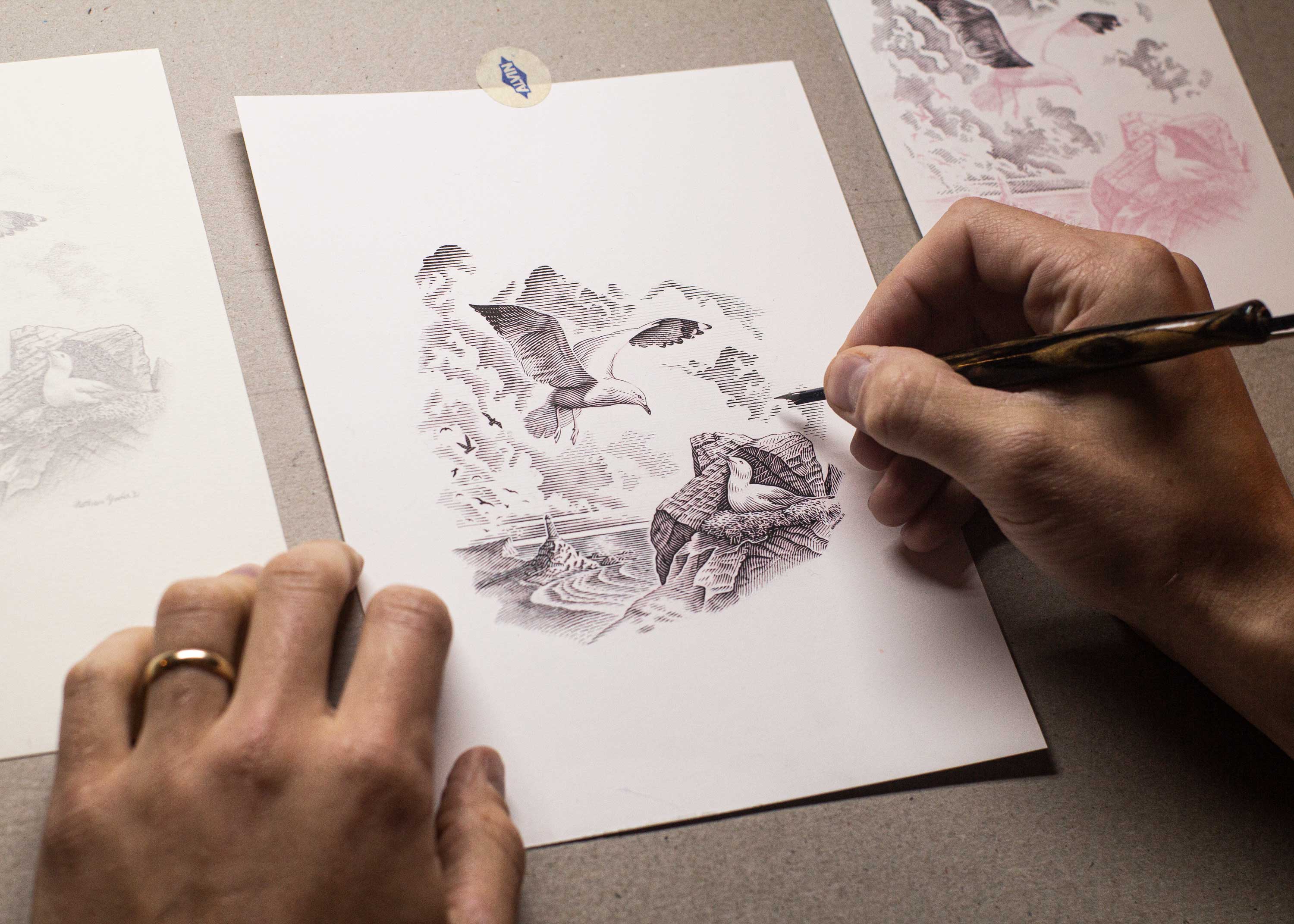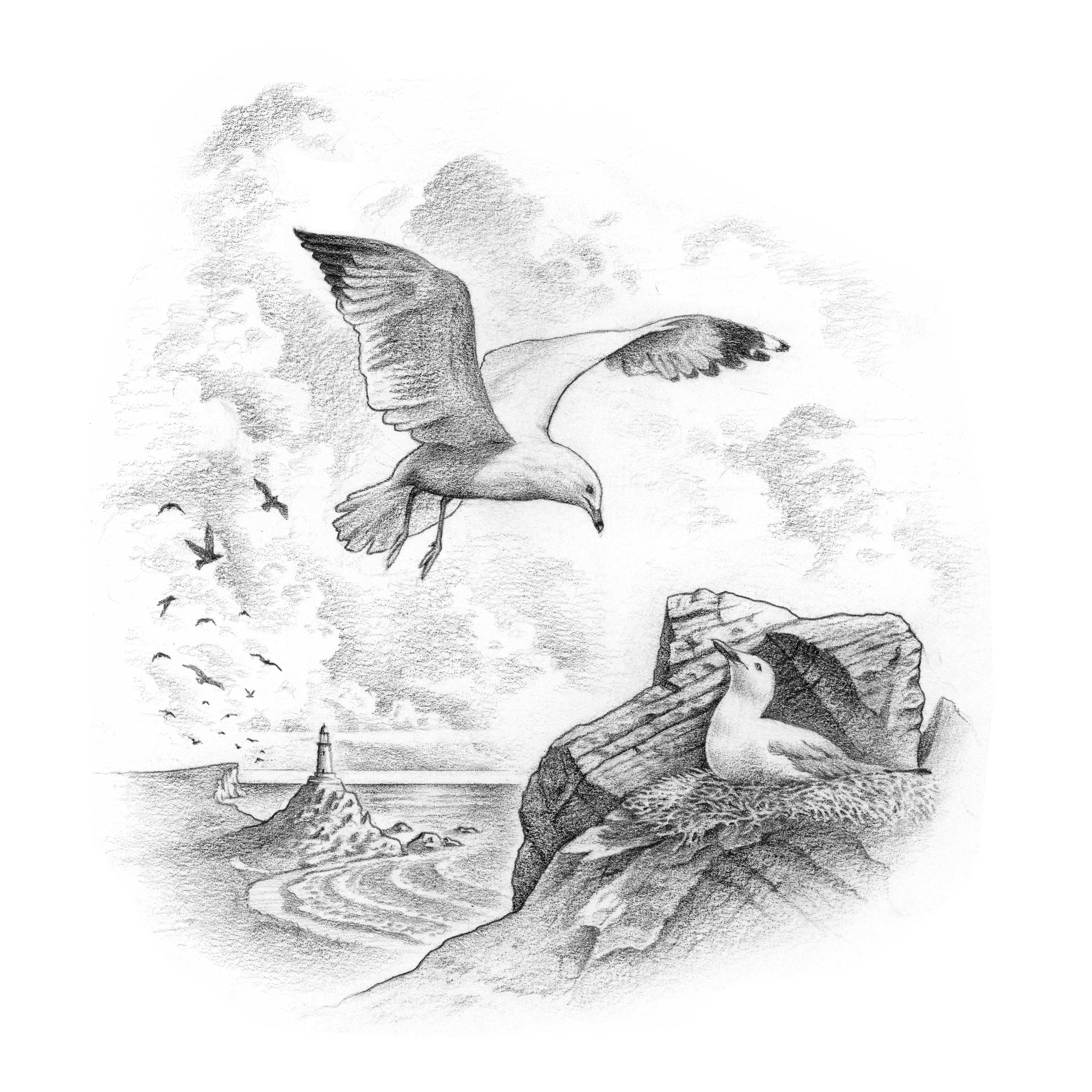Process
A general overview of workflow, timing, & pricing
Introduction
Thank you for your interest in my work. The following is a glimpse into what you can expect in working with me.Note:
At the end of this page you will also find a short explanation of how I quote projects.
Phases Of A Project
While each job comes with its own particular set of needs every job can be broken down into four distinct phases; 1. Ideation; 2. Sketches; 3. Revisions; and 4. Finals. The following is an example of this process. Regardless of the project or particular illustration style that you’re after, the same general process applies.
Phase 1: Ideation
Most projects are initiated by an email, from someone such as yourself, containing a short summary of the project in question or—better yet—by the completion of my project-inquiry form. I will then followup to confirm availability and ask any followup questions that I might have for you before providing an initial estimate on cost and timing.
Generally speaking, once an agreement has been made, we will kick things off with a short call. This will allow you the opportunity to better articulate your needs and me the ability to better understand them. Depending upon the scope of our agreement, I may then perform research and compile imagery that reflects the general direction we intended to head in. This will be presented to you in the form of a web-based presentation (as will be done for each phase of our collaboration). After receiving your feedback, I then set to work on rough sketches.
Phase 2: Sketches
In the example provided below, one initial sketch was required, your project may require more. Most initial sketches are loose in nature and lacking in fine detail. The main idea here is to quickly communicate the composition and general mood of the illustration before investing too much time in a direction that may not be the right fit for your project. These sketches will then be presented to you.
![]()
Most projects are initiated by an email, from someone such as yourself, containing a short summary of the project in question or—better yet—by the completion of my project-inquiry form. I will then followup to confirm availability and ask any followup questions that I might have for you before providing an initial estimate on cost and timing.
Generally speaking, once an agreement has been made, we will kick things off with a short call. This will allow you the opportunity to better articulate your needs and me the ability to better understand them. Depending upon the scope of our agreement, I may then perform research and compile imagery that reflects the general direction we intended to head in. This will be presented to you in the form of a web-based presentation (as will be done for each phase of our collaboration). After receiving your feedback, I then set to work on rough sketches.
Phase 2: Sketches
In the example provided below, one initial sketch was required, your project may require more. Most initial sketches are loose in nature and lacking in fine detail. The main idea here is to quickly communicate the composition and general mood of the illustration before investing too much time in a direction that may not be the right fit for your project. These sketches will then be presented to you.

Phase 3: Revisions
Once you’ve had a chance to review, we may then schedule another call to discuss your feedback. Once received, I will then proceed to apply your feedback and further develop the sketch. Most projects will consist of two rounds of revisions.
![]()
Depending upon our agreement, the final illustration style to be used may not be applied until the end of the process. This is due to the fact that it is much quicker to develop a sketch with a pencil, using tonal values, than it is to do so with lines. Nonetheless, hints at line work will often be overlayed to communicate how the line work will fall over the subjects within the illustration.
Once you’ve had a chance to review, we may then schedule another call to discuss your feedback. Once received, I will then proceed to apply your feedback and further develop the sketch. Most projects will consist of two rounds of revisions.

Depending upon our agreement, the final illustration style to be used may not be applied until the end of the process. This is due to the fact that it is much quicker to develop a sketch with a pencil, using tonal values, than it is to do so with lines. Nonetheless, hints at line work will often be overlayed to communicate how the line work will fall over the subjects within the illustration.
Phase 4: Final Artwork
Once the sketch has been revised and refined to a satisfactory point, final artwork is then produced. Most all final artwork is made on paper using traditional mediums although occasionally final artwork is created in a purely digital format. In any case, all final deliverables are shared as vector .ai files, unless otherwise specified.
Once the sketch has been revised and refined to a satisfactory point, final artwork is then produced. Most all final artwork is made on paper using traditional mediums although occasionally final artwork is created in a purely digital format. In any case, all final deliverables are shared as vector .ai files, unless otherwise specified.

At this phase, it becomes increasingly important that all revisions to the artwork have been expressed and addressed. Revisions made to final artwork, while possible, do require more time and may merit additional fees.

Toolkit
The applications and tools listed below are those which are common in my creative process. While I primarily work on paper, all of my work is finally scanned into the computer where minor revisions and touch up work is completed using my Wacom Cintiq tablet within Photoshop and/or Illustrator.Hardware
- Pen & Pencil
- Paper & Scratchboard
- Mac Studio
- Wacom Cintiq Pro
Software (Adobe CC)
- Photoshop
- Illustrator
- InDesign

Pricing
Please note that I do not quote based on an hourly rate. Rather, when preparing a proposal, I take into account the entirety of a project’s scope. This includes factors such as usage (how, where, and for how long the artwork will be used), the level of detail required in the rendering of the artwork, how soon the artwork is needed…etc. I have found project based pricing to be most effective in keeping both artist and client accountable to a clearly defined agreement. That is to say, the artist does not abuse an hourly rate at the client’s expense and the client keeps feedback clear and concise within a limited number of revisions to ensure that the project stays on course.Base Rate
In most cases, projects must meet a budgetary threshold of $3,500 to be booked in advance. While projects with budgets falling below that threshold are negotiable, compromise cannot be guaranteed.
Turnaround
The turnaround time of a project primarily depends on the number of deliverables needed, the complexity of each, and the level of availability that I have open at any given time. That said, the ideal timeline for a project, similar in nature to the case study shown above, is between three and four weeks. Similar jobs have been completed within a single workweek. That said, such tight turnarounds are often accompanied by a rush fee proportionate to the amount of time that has been shaved off of the project’s originally estimated duration and depend upon my level of availability at any given time.Ready To Get Started?
Complete a project inquiry form to receive an estimate on cost and timing for your project. In most cases this can be returned by the end of the following business day.I look forward to hearing from you!
- Nathan
REQUEST AN ESTIMATE

